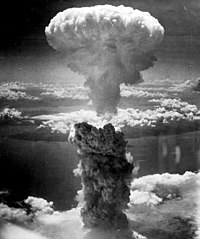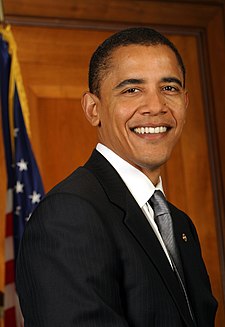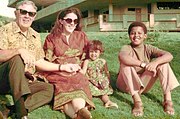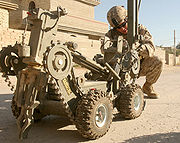NUCLEAR WEAPON

A nuclear weapon (sometimes called a nuclear bomb) is a type of weapon of mass destruction and an explosive device that derives its destructive force from nuclear reactions (either fission or a combination of fission and fusion). Both reactions release vast quantities of energy from relatively small amounts of matter; a modern thermonuclear weapon weighing little more than a thousand kilograms can produce an explosion comparable to the detonation of more than a billion kilograms of conventional high explosive. Even small nuclear devices with yields equivalent to several thousand tons of TNT can devastate a city. Nuclear weapons are considered weapons of mass destruction, and their use and control has been a major aspect of international policy since their debut in Nagasaki and Hiroshima.
In the history of warfare, only two nuclear weapons have been detonated offensively, both during the closing days of World War II. The first was detonated on the morning of August 6, 1945, when the United States dropped a uranium gun-type device code-named "Little Boy" on the Japanese city of Hiroshima. The second was detonated three days later on August 9, 1945, when the United States dropped a plutonium implosion-type device code-named "Fat Man" on the city of Nagasaki, Japan. These bombings resulted in the immediate deaths of around 120,000 people (mostly civilians) from injuries sustained from the explosion and acute radiation sickness, and even more deaths from long-term effects of (ionizing) radiation. The use of these weapons was and remains controversial. (See atomic bombings of Hiroshima and Nagasaki for a full discussion.)
Since the Hiroshima and Nagasaki bombings, nuclear weapons have been detonated on over two thousand occasions for testing purposes and demonstration purposes. The only countries known to have detonated nuclear weapons – and that acknowledge possessing such weapons – are (chronologically) the United States, the Soviet Union (succeeded as a nuclear power by Russia), the United Kingdom, France, the People's Republic of China, India, Pakistan, and North Korea. Israel is also widely believed to possess nuclear weapons, though it does not acknowledge having them. For more information on these states' nuclear programs, as well as other states that formerly possessed nuclear weapons or are suspected of seeking nuclear weapons, see List of states with nuclear weapons.
Nuclear strategy

Nuclear warfare strategy is a way for either fighting or avoiding a nuclear war. The policy of trying to ward off a potential attack by a nuclear weapon from another country by threatening nuclear retaliation is known as the strategy of nuclear deterrence. The goal in deterrence is to always maintain a second strike status (the ability of a country to respond to a nuclear attack with one of its own) and potentially to strive for first strike status (the ability to completely destroy an enemy's nuclear forces before they could retaliate). During the Cold War, policy and military theorists in nuclear-enabled countries worked out models of what sorts of policies could prevent one from ever being attacked by a nuclear weapon.
Different forms of nuclear weapons delivery (see below) allow for different types of nuclear strategy, primarily by making it difficult to defend against them and difficult to launch a pre-emptive strike against them. Sometimes this has meant keeping the weapon locations hidden, such as putting it on submarines or train cars whose locations are very hard for an enemy to track, and other times this means burying them in hardened bunkers. Other responses have included attempts to make it seem likely that the country could survive a nuclear attack, by using missile defense (to destroy the missiles before they land) or by means of civil defense (using early warning systems to evacuate citizens to a safe area before an attack). Note that weapons which are designed to threaten large populations or to generally deter attacks are known as strategic weapons. Weapons which are designed to actually be used on a battlefield in military situations are known as tactical weapons.
There are critics of the very idea of nuclear strategy for waging nuclear war who have suggested that a nuclear war between two nuclear powers would result in mutual annihilation. From this point of view, the significance of nuclear weapons is purely to deter war because any nuclear war would immediately escalate out of mutual distrust and fear, resulting in mutually assured destruction. This threat of national, if not global, destruction has been a strong motivation for anti-nuclear weapons activism.
Critics from the peace movement and within the military establishment have questioned the usefulness of such weapons in the current military climate. The use of (or threat of use of) such weapons would generally be contrary to the rules of international law applicable in armed conflict, according to an advisory opinion issued by the International Court of Justice in 1996.
Perhaps the most controversial idea in nuclear strategy is that nuclear proliferation would be desirable. This view argues that, unlike conventional weapons, nuclear weapons successfully deter all-out war between states, as they did during the Cold War between the U.S. and the Soviet Union. Political scientist Kenneth Waltz is the most prominent advocate of this argument.
It has been claimed that the threat of potentially suicidal terrorists possessing nuclear weapons (a form of nuclear terrorism) complicates the decision process. Mutually assured destruction may not be effective against an enemy who expects to die in a confrontation, as they may feel they will be rewarded in a religious afterlife as martyrs and would not therefore be deterred by a sense of self-preservation. Further, if the initial act is from rogue groups of individuals instead of a nation, there is no fixed nation or fixed military targets to retaliate against. It has been argued, especially after the September 11, 2001 attacks, that this complication is the sign of the next age of nuclear strategy, distinct from the relative stability of the Cold War.











